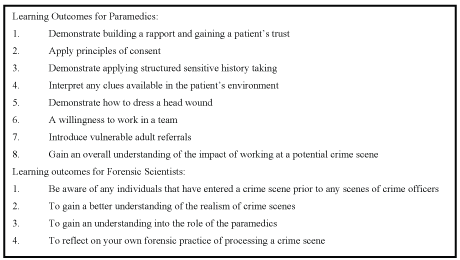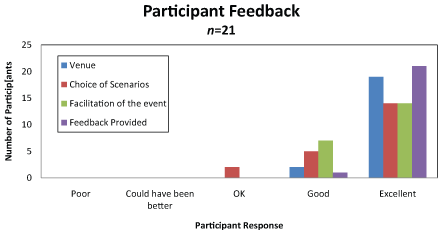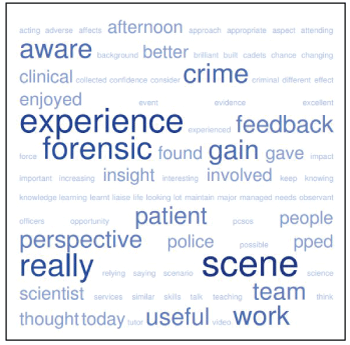
Figure 1: Learning Outcomes for Collaboration Days


Baljit Ghatora1* Layla Renshaw1 Lisa Burrell2 David Doran2
1Kingston University, Faculty of Science, Engineering and Computing, School of Life Science, Pharmacy and Chemistry, Penrhyn Road, Kingston Upon Thames, Surrey, KT1 2EE, UK*Corresponding author: Baljit Ghatora, Kingston University, Faculty of Science, Engineering and Computing, School of Life Science, Pharmacy and Chemistry, Penrhyn Road, Kingston Upon Thames, Surrey, KT1 2EE, UK, Tel: 0208 417 7482; E-mail: B.Ghatora@Kingston.ac.uk
A “real-world” collaborative learning experience across disciplines can be used to enhance the students learning experience, not only to increase student satisfaction across the course but also to develop professionally prepared, aware and equipped graduates in STEM subjects. This short communication explores the creation of a collaborative learning environment between Paramedic and Forensic science degree students. This research forms part of a pilot study to assess the suitability of introducing such extracurricular activities within a Forensic curriculum.
Inter-professional; Collaborative learning; Prepared graduates
A theory which may be considered within the simulation learning environment is Experiential Learning, a theory which suggests, that knowledge and learning are developed through exposure to real-life experiences [1]. Experiential Learning is presented by Kolb as using a four-stage cycle to demonstrate how experience develops learning and knowing [2,3]. Using this theory within a planned educational simulation exercise allows for opportunities through which students can share ideas and learn from the exercise as well as from each other.
The Forensic science programme at Kingston University is delivered by staff within the School of Life Sciences, Pharmacy and Chemistry. The programme is designed to furnish students with a broad range of analytical and investigative skills and apply them to criminal investigations.
The Scenes of Crime house is used as an experiential learning space in which simulated crime scenes are set up and students are required to put into practice the theory learnt around being a crime scene officer. They are formatively assessed on their understanding of the recovery, collection and documentation of evidence retrieved from a crime scene, and students would have no interaction with any other disciplines at the crime scene due to resources. However in a real crime scene, the crime scene officers may not always be the first ones onto a scene. The paramedics may be first to aid any victims or even interact with suspects or perpetrators.
The College of Paramedics recommended within the recent edition of the curriculum guidance (2014) [4] that paramedic education should include Inter-professional Learning (IPE) “when two or more professionals learn with, from and about each other to improve collaboration and the quality of care [5].” Although this understanding is predominantly placed within the healthcare setting, there are circumstances when health care professionals will need to consider and work alongside other professionals in their delivery of care, and the out-of-hospital environment presents these opportunities and challenges. The paramedic science degree is designed to prepare paramedic students for the unique challenges they may face in delivering high quality medical care in an un-predictable and changing working environment. Paramedics will often be amongst the first on scene in crimes involving injury and can inadvertently have an impact on the scene assessed by forensic professionals. It is suggested in situation learning theories that learners develop within a particular setting and through interaction with others [6]. This allows learners to develop from, “Legitimate peripheral participators” to “full participation in the sociocultural practices of a community [7]”. This raises the question that perhaps IPE should also be considered within the Forensic science community. Forensic science is indeed the application of science to serve the justice system; however there are currently limited opportunities for students to explore the un-predictable nature of crime scenes and the subsequent effect it has on the evidential value on evidence collected from the crime scene.
Multidisciplinary learning can help prepare graduates to interact with professionals from different fields [8]. Therefore it is envisaged that collaborative learning with paramedic and forensic science students will allow them to become more engaged with the effects that their actions have on other disciplines involved at an emergency or a crime scene and understand the complexity of real-world cases. Making simulation mimic reality increases learning, creating realistic scenarios is therefore highly desirable. It will enable both disciplines to reflect upon their wider professional skills and gain an understanding and appreciation into the roles of other professionals at crime scenes. The activity also uses peerobservation, self-reflection, and the giving and receiving of feedback, which are important learning and employability skills.
Joint simulation days have been co-ordinated across both disciplines for the past few years where the event is offered to paramedic and forensic students as an extracurricular activity over the summer period. At the Scene of Crime House, various simulated crime scenes are set up using actors/actresses and different evidence types. Learning outcomes (Figure 1) are identified for each set of students which will allow the activities to be facilitated and learners to ensure they are aware of the benefits of the event. These were designed using the theory of setting curriculum goals by Harden et al. [9], who states that when designing inter-professional learning activities one must not confuse teaching the discipline specific knowledge with the primary goals/outcomes of the collaborative experience. For example when students are given an assault scene as their common goal, this will be the vector used to learn how to work in synergy with all professionals who will have contact with that scene. The purpose of the joint simulation days was made very clear from the onset, where we had decided that we wanted students to apply knowledge gained previous learning from their individual disciplines into practice in a new situation. Blooms taxonomy refers to these learning objectives as cognitive objectives which are frequently used in higher education [10]. Students were explicitly aware what they must do something, to demonstrate that learning has taken place. In addition to the above, learning outcomes must allow mutual respect to be gained, implying knowing other professionals at the crime scene and their contributions to the scene, as well as working with others to effect change and resolve any conflict in the integrity of the crime scene and preservation of life.

Figure 1: Learning Outcomes for Collaboration Days
The paramedic students would enter this crime scene and are required to provide acute medical management and facilitate appropriate onward referral of the patient/victim of crime. This stage is filmed to record changes to the scene that occur through clinical management. When the forensic students then enter into the crime scene they will process the scene as normal. After the scene has been processed all students convene and summarise their experiences together, using structured selfreflection sheets and group discussion.
A review of the post-practical video will allow shared awareness of the activity that takes place at a crime scene, and allows an element of reflective learning which is not always possible in real-time role playing. It will allow them to become more engaged with the effects of their actions on other disciplines involved at a crime scene and explore key issues such as contamination. Paramedic video footage will allow forensic students to look at the importance of their skill set ‘from a distance’ and provide them with an opportunity to receive critique from peers from other disciplines. Forensic students will be able to reflect upon the evidence they have collected and share their discipline specific knowledge. More importantly forensic students will gain the insight that much of their work will not occur in sterile or controlled environments such like the simulated crime scenes they have experienced at university, but they will involve complex, changing scenes and interactions with the public and other agencies and professionals with different working practices and priorities.
Paramedic science students will develop an awareness of the activity that takes place at a crime scene and become more engaged with the effects that their actions have on other disciplines involved at a crime scene. This reinforces the theory that learning goes beyond being a purely psychological process of development, but is influenced through the interaction between the individual and the learning environment [11]. They will also reflect upon how they will document the scene from their point of entry through to exiting the scene, considering the importance of the collection of evidence for crime scene evaluation.
The last extracurricular experience saw a total of 21 participants of which 10 were Forensic Science students and 11 were Paramedic science students. The numbers were restricted due to the space available within the 4 rooms in the scenes of crime house. The event on the day was split up into 3 sessions “Scene management Paramedics” “Scene management Forensics” “Debrief, Refection group discussions between Paramedics & Forensics and Feedback.” At the start of the daylong event the students were presented with a case study, which provided details into the case e.g. assault, burglary etc. Only limited key information and specific items of evidence were placed at the scene to create an element of realism to the scene. More variables were introduced by having both a forensic and medical dimension to the scene
The paramedics entered the scene first and were filmed whilst completing the tasks that were associated in preserving any life, or dealing with injured patients. Straight after the paramedic interaction Forensic scientists were assigned to each scene and they began processing the scene to preserve and collect evidence, again these interactions were filmed.
After all scenes had been processed the two disciplines met up and watched footage from each scene management. The technical and non technical skills that each discipline gained were discussed whilst they carried out self- reflection and critical thinking. There was a marked improvement in student performance when they processed their scenes because they were being observed by others. When students know that their work will be viewed and evaluated by peers, this usually provides them with the motivation to ensure they demonstrate a higher level of behaviour as their peers will be their audience, it is almost an element of showcasing their skills [12]. It has been shown that “prompt feedback” that can be provided through video recording actions/role play is very effective in improving learners skills [13]. Therefore as a result of listening to feedback from a different subject area, it encourages students to get a fresh perspective and more critical distance on their own work [14].
Feedback was sought from students after the joint simulation day and this was carried out via anonymous questionnaires at the end of the session. The students were asked to provide feedback on four main areas of the event; venue selection, choice of scenarios presented, facilitation of the event and feedback received; a summary of these results are shown in Figure 2. Considering that majority of the feedback carried out in these sessions was through self-reflection and peer feedback, it is promising to note that all students, apart from one, feel that the feedback was excellent.

Figure 2: Summary of Anonymous Questionnaires
Participants were able to leave free text comments too- and these were converted into a word cloud (Figure 3) to identify common themes. It should be noted that the majority of the free text comments came from the Paramedic students. The students clearly felt that the experience had created a greater awareness for them as this was mentioned in several free text comments “be more aware” “made me aware” “better awareness.” This form of deep critical thinking and self-reflection demonstrates that the students have seen beyond their own subject discipline and have learnt to respect the roles and responsibilities of others as well as break down any stereotypical perceptions that each profession may have about one another as portrayed by the “CSI effect” or hospital TV dramas [15]. There was also clear evidence to suggest that the process of learning from others had been achieved in this inter-professional learning environment as some of the students had commented that they “had a chance to talk to the forensic team and gain experience from them” “learnt knowledge in how to keep crime scenes as appropriate as possible for the forensic team” “gained an insight into how the Forensic team work.” All these responses suggest that inter-professional learning between these two disciplines was an effective way of enabling learners to acquire knowledge and skills, and also professional attitudes which they would not normally be able to acquire in any other way. They have also gained an enhanced understanding into how effective team work at a crime scene is vital, even when these two professions may not actually meet face to face in the actual environment. Interestingly, students had demonstrated that this had enhanced their critical thinking skills because some free text comments had indicated suggestions for improvements “Would be a good experience to do a similar day with the police” “Would be good to involve the police officers/PCOs etc.” They have indicated a desire to learn from other professionals too, which shows that they have valued the inter-professional exposure and are willing to engage in further activities to learn from others “I learnt a lot about our own work and the paramedics too.”

Figure 3: Word Cloud of free text feedback from participants
It is apparent that both sets of participants (Forensic and Paramedics) enjoyed the experience and allowed them to gain a wider perspective of the scene of crime. It is interesting to note that inter-professional practice is very common in the nursing, medical and Pharmacy professionals; however in traditional science subjects we see less of it. There is slowly an emerging interest for health care professionals such as Nurses to be made aware of the underlying science behind Forensics; however what they ultimately need is simply to be able to interact with other disciplines and understand what they do together in order to provide a more efficient and judicial justice system [16,17]. In the real world forensic scientists and paramedics work very closely with each other, the crown prosecution services, police and law professionals as well as other emergency services that enter a crime scene, however there is no interaction with these professions during the learning stages in undergraduate degree programmes. In order to correctly prepare the future professionals that will be working in a very complex and ever changing environment such as a crime scene, there needs to be enhanced consultation and discussion encouraged between all those disciplines in the learning stages in order to cultivate a critical conception of the roles and values of other professionals at the crime scene [18].Through this joint simulation day it has emerged that there is scope for other disciplines to get involved too for example digital crime experts and lawyers; that see the final stages of any criminal case. The exposure to this type of learning however needs to be constant using an incremental approach as Charles et al identifies that continued exposure is necessary to challenge biases, attitudes and beliefs so that new ways of thinking are adopted [19].
As this was a set of pilot studies we should reflect on the content that was designed and on the student’s experiences, according to Kolb’s learning cycle, to make it a more enriched learning opportunity [2]. Although students enjoyed the experience further developments should be explored, including making it a compulsory part of the curriculum as professionals from a number of disciplines would enter onto a crime scene. It would equally be useful to include participation from fire, police services, witnesses and cyber investigation units which would replicate the magnitude at which real crimes are investigated. It would also be worth aligning measurable learning outcomes to student self reflection logs/activity sheets which would allow students to reflect and evaluate their own practices in more detail whilst demonstrating critical thinking.
Download Provisional PDF Here
Article Type: RESEARCH ARTICLE
Citation: Ghatora B, Renshaw L, Burrell L, Doran D (2017) Interprofessional Learning across the Forensic Science and Paramedic Science Degrees. J Forensic Res Ana 1(1): dx.doi.org/10.16966/2577-7262.105
Copyright: © 2017 Ghatora B, et al. This is an open-access article distributed under the terms of the Creative Commons Attribution License, which permits unrestricted use, distribution, and reproduction in any medium, provided the original author and source are credited.
Publication history:
All Sci Forschen Journals are Open Access